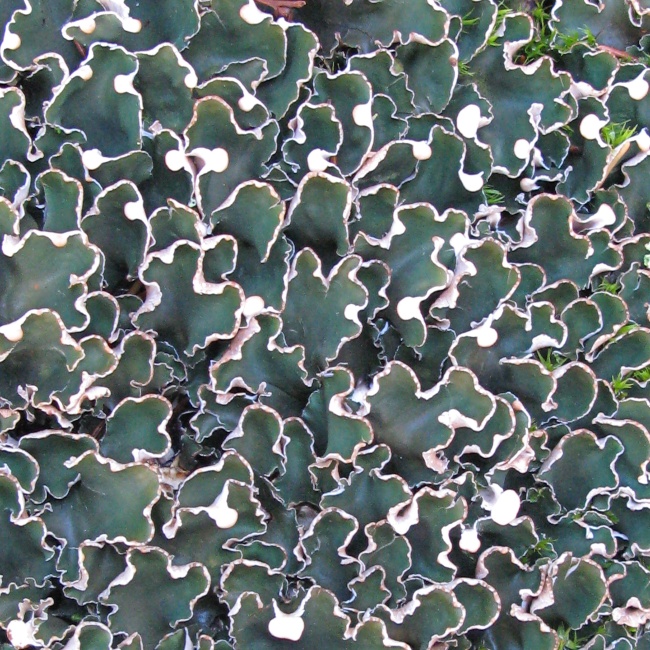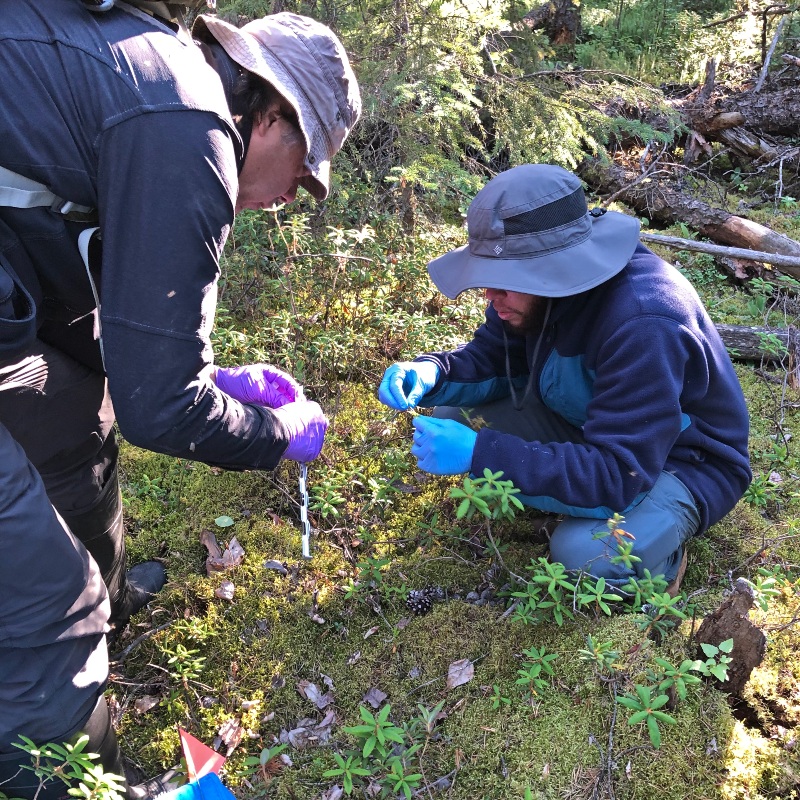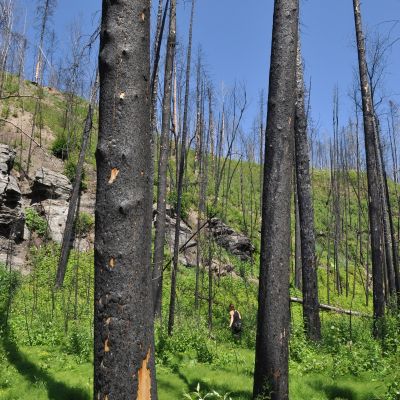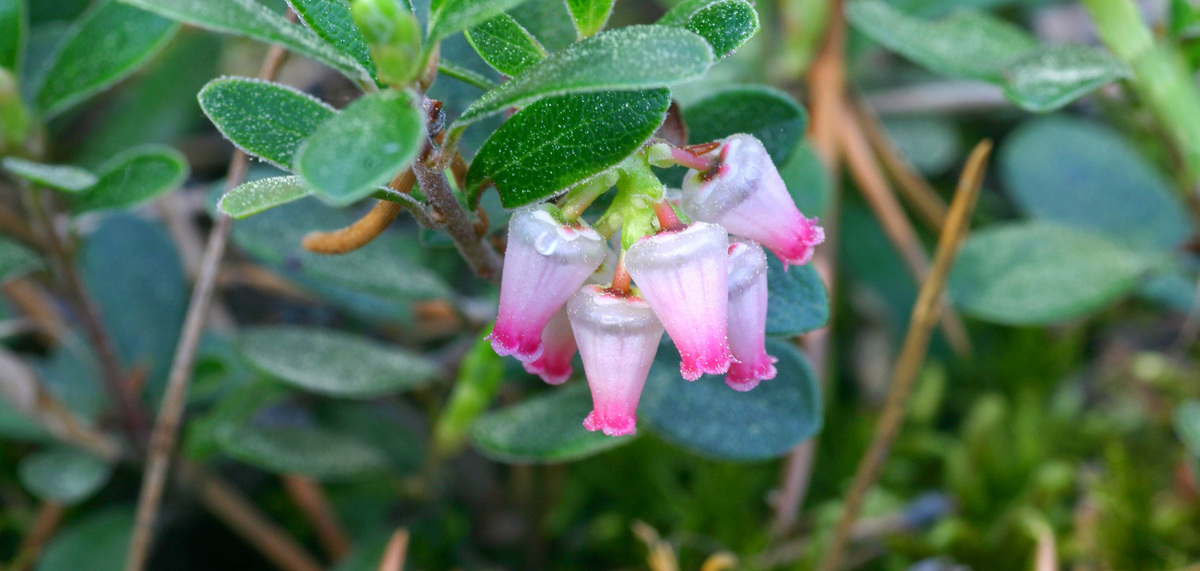
The Peltigera Project
Categories: Taxonomy
Status: In Progress
About the Project
The ABMI strives to continuously improve our monitoring program by exploring new technologies that are cost and time effective and produce scientifically sound data.
The Peltigera project started with a desire to expand our understanding of Peltigera lichen diversity in Alberta through genetic markers. Building on the research done by global Peltigera experts at Duke University led by François Lutzoni and Jolanta Miadlikowska, we hoped to use genetic data to both verify our identifications and detect new species to the province.


Sampling Peltigera lichens in the field
Thanks to Duke Ph.D. Candidate Carlos Pardo De la Hoz, the project expanded to understanding what factors shape the distribution of all of Alberta’s cyanolichens—lichens with cyanobacteria as photosynthetic partners—using ABMI collections.
Currently funded by a National Science Foundation grant entitled “Spatio-temporal factors shaping cyanolichen networks”, more details on the larger initiative can be found here: http://lutzonilab.org/cyanolichen-networks/project/
Peltigera is a genus of lichen-forming fungi, so named because they often form leafy lichens resembling animal pelts. These large lichens are conspicuous and diverse in many terrestrial habitats across Alberta.
Recent work by the Lutzoni lab has shown that we are dramatically underestimating the number of Peltigera species worldwide, in part because many species look very similar to each other (see reference 1). Genetic data can be used to tease these similar species apart.
Prior to this collaboration, 24 species of Peltigera were known from Alberta. As of 2022, we now know Alberta is home to at least 58 Peltigera species and to another 10 that may be new species to science.
Peltigeras are cyanolichens. Cyanolichens are lichens that have a cyanobacterial partner (commonly Nostoc), providing sugar and nitrogen to the partnering fungus.


- Cyanobacteria are important ecologically because they fix atmospheric nitrogen into compounds other organisms can use.
- Cyanolichens have different moisture and temperature needs than lichens with green algal partners and in many cases are more sensitive to air quality and changes in climate.
- Including Peltigera, Alberta is home to an estimated 27 genera and 160 species of lichens that are either dominated by cyanobacteria (cyanolichens) or that include cyanobacteria among their photosynthetic partners (cephalolichens).
Our Approach
At the heart of the Peltigera Project is the ABMI’s systematic lichen sampling across Alberta. Those samples are providing the genetic basis from which to ask fundamental questions about why some species are specialists and others are generalists and how these symbiotic interactions shape cyanolichen communities.
- To date, the ABMI has provided small samples of all cyanolichens collected from 483 visits to 448 different locations across Alberta, for a total of 3,980 individual samples.
- These samples were sequenced at Duke University, and we are currently finalizing identifications of both the fungal and cyanobacterial partners, creating a dataset of associations to answer the questions above.
- In 2022 we conducted additional field work at 15 sites across Alberta to better understand the distribution of the cyanobacteria when growing independently from cyanolichens.

This project has resulted in an invaluable collection of sequenced lichens, helping us verify and improve our morphological taxonomy and allowing us to explore subtle traits to help differentiate many of the new species to Alberta. No institution in the world outside of Duke University has as many sequenced cyanolichens. Check back here for future updates!
This study was partially funded by the National Science Foundation (NSF) awards BEE 1929994 to François Lutzoni and Jolanta Miadlikowska. We thank the Vancouver Foundation in British Columbia, Yukon Territory, Northwest Territories, and NatureServe for funding contributions to this work from outside of Alberta. The ABMI thanks our project collaborators: Duke University – François Lutzoni, Jolanta Miadlikowska, Carlos J. Pardo De la Hoz, Ian D. Medeiros, and Nicolas Magain. University of British Columbia – Trevor Goward. We’re grateful to the staff and volunteers that have helped sample and sequence the collections: Darcie Thauvette (ABMI), Spencer Goyette, Will White (Duke), Sydney Toni (ABMI), Alessandra Hood, and Mireille Martel (ABMI).
The 'Almanac of Alberta Acari' series are compendiums of information on the known mites in Alberta, including collection records, keys, illustrations, and ecological information.
The Biodiversity Trajectories (BDT) project is a multi-year, collaborative project between the ABMI and seven forestry companies in Alberta.
BERA focuses on understanding the effects of industrial disturbance on natural ecosystem dynamics in the boreal forest, and developing strategies for restoring disturbed landscapes in a system that is under pressure from climate change.



